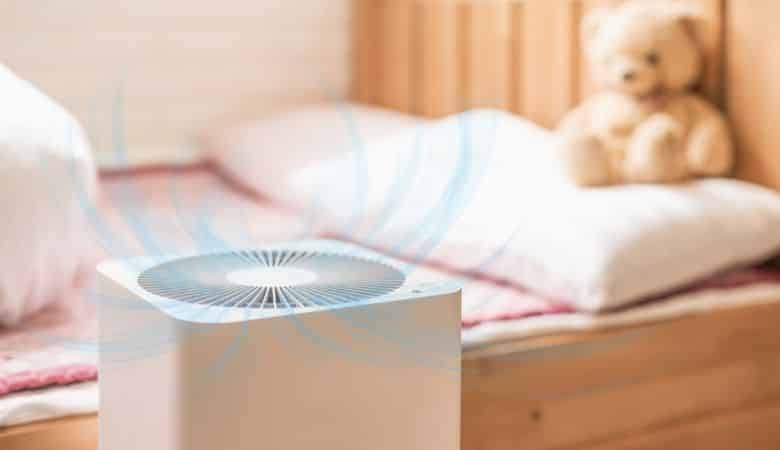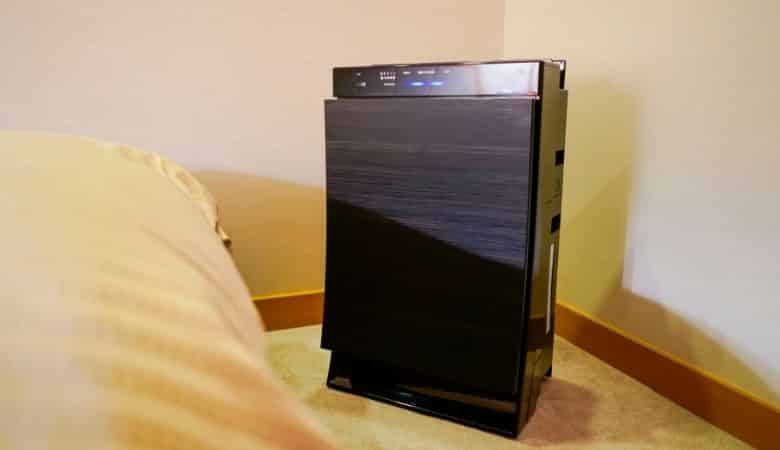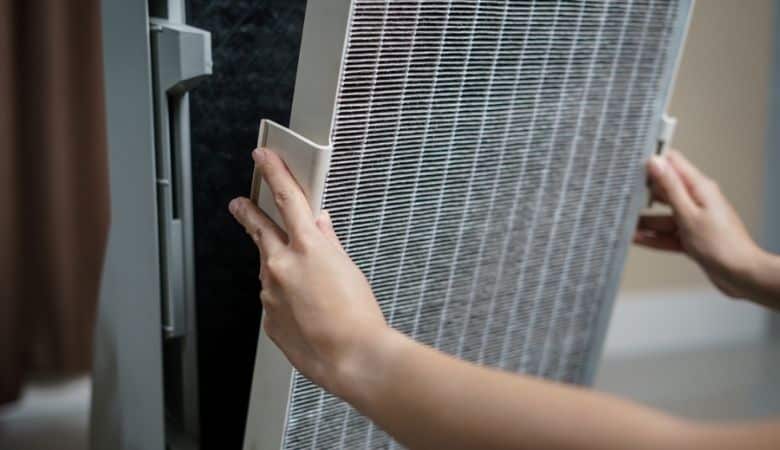Did you know the efficiency of an air purifier increases by as much as 20 percent if it is positioned at the right place, for the right time, and facing the right direction?
The air purifier performs the essential function of plucking pollutants in your home to make the air cleaner. Therefore, getting the most of your appliance requires getting everything right, especially the placement.
Quick and To-The-Point Guide
- Place between 6 and 10 feet from your bed head.
- Try to make sure it is at the center of the room, away from any blockage.
- If there is a source of smoke or smell, place the air purifier close to it.
- Shut windows and doors.
- Place away from the floor and electronics.
The above is a quick tweak and a basic rule for placing the air purifier in your room. However, different situations could arise, demanding different methods, but don’t worry. We have dedicated the following lines to an in-depth explanation of how to use air purifiers, including positioning and maintenance.

Why Can’t I Just Place My Air Purifier in Any Position in the Bedroom?
An air purifier has to be positioned strategically; else, you would end up with less than half of the overall capacity. Generally, how and where you place the appliance should be a consideration of multiple factors, including the type of purifier and the room design.
Even though many air purifiers are designed to be placed on the floor, wall, or desk, it is still essential to weigh other factors when making the placement. For instance, air circulation within the room is either horizontal or vertical. This usually takes the hotter air towards the upper part of the room, and proper positioning would be key to getting efficiency.
Most air purifiers also have their functional parts on a certain part of the appliance. Therefore, proper positioning requires that those parts are facing the part of the room that needs the most filtering. All these factors signify that you cannot place the air purifier just anywhere; instead, it has to be a deliberate action.
Luckily, most air purifiers are portable, meaning they can be moved appropriately at any time of the day. Simply place them accordingly, and you’re on your way to breathing fresh air and having a clean atmosphere.
Where Should I Place My Air Purifier?
1. Place in an open space
The air purifier needs to be placed in an open space with high airflow; not a corner, behind a chair, or below a table. That is because a corner has limited airflow. Placing an air purifier in a closed or semi-closed space prevents the machine from reaching the other parts of the room.
In the same vein, a table will block the inflow of fresh air when the purifier is placed under it. Aside from the issue of poor ventilation, this may also mean putting the appliance on the floor, another positioning that isn’t advisable.
For optimum efficiency, an air purifier should be in an open space where there is no obstruction to the sides, front, or top.
2. Make sure it’s facing the right direction

You want to make sure the air purifier is effectively making the air in the bedroom cleaner and healthier. That is why the front should be placed facing the wider part of the room, especially if you have a small room.
If the bedroom is large, you may have to move the appliance closer to the bed, about 6 to 10 feet, so it filters the air you’re breathing in.
3. Place away from the ground
It is recommended that you elevate the air purifier around 3 to 5 feet high, using a dresser or any piece of furniture. This enhances the efficiency of the purifier, as it is able to collect contaminants from every part of the room.
Also, keeping it off the ground helps to eliminate the danger of tripping on the appliance.
4. Place near the source of pollution
If you have a source of pollution in your room, such as a cloud of smoke or foul smell, placing the air purifier near the source is a good idea for eliminating the pollution.
You can detect this easily by sniffing around. However, you could also use an air quality monitor to detect the position where the pollution is worse if you’re not sure.
If the source of smoke or smell is from outside the room, then it might be a good idea to have the purifier stationed by the entrance, vent, or window. This ensures that the contaminant is sucked out, leaving the air you breathe fresh.
5. Shut the windows and doors
The effectiveness of air purifiers comes into play when you have all windows and doors shut. Closing these spaces allows the air purifier to work without any interference from outside.
If you do not do this, it means the appliance is cleaning the air from larger and multiple locations, which will take time and reduce efficiency.
Air purifiers are capable of drawing in air from anywhere, and having the doors or windows open means they continue to attract air from outside.
Just like you should shut the space when you’re using an air conditioner because it cannot keep the entire atmosphere outside cool, you should treat the air purifier the same way.
6. Don’t expose to too much moisture
Air purifiers do not do well with high humidity because too much moisture translates to heavier air. Heavier air means that the purifier has to exert more energy for purification.
Too much moisture also reduces the performance of certain filters, like the HEPA filters. Therefore, you may want to use a dehumidifier to get rid of heavy air before using the purifier.
7. Don’t place near electronics
Electronic appliances, such as microwaves, television, stereo, etc. should not be positioned near the air purifier; else, there may be harmful interference. This is because they operate using identical wavelengths. The ideal distance between an air purifier and any of these electronics should be around 5 feet.
How to Clean and Maintain Your Air Purifier: Step by Step

Frequent cleaning and maintenance are crucial for the proper operation of the air purifier. A purifier has cleanable parts, such as the prefilter, filter, and sensor lens.
The prefilter is like a plastic window that covers the filter itself. This barrier traps large particles and prevents them from getting to the filter. To clean the prefilter, you need to vacuum-clean, wipe with a clean fabric as specified in the manual, and rinse off with water.
The dust sensor lens is another part that is cleanable within the air purifier. This is not always present, but when it is, it works with advanced logarithms to keep track of particles trapped by the laser beam. This sensor is usually dusty and must be cleaned once or twice every month for optimal results.
As for filters, you need to clean them every ten days. Some of them, like carbon and HEPA filters, cannot be cleaned; instead, you need to replace them every year. You can find information on the cleanable filters and how to clean them within the instructional manuals. However, the general cleaning process is as follows:
- Put on protective gear, such as gloves and a nose mask. This will prevent you from damaging the air purifier, getting injured, or getting affected by allergens and pollutants.
- Carry out the process outside the room and away from people.
- Unplug the air purifier before you commence cleaning.
- Start cleaning from the exterior and make sure you get rid of dirt with a damp fabric.
- Vacuum-clean the air intake component.
- Separate the parts and filters before vacuum-cleaning them. Be very careful with the delicate parts to avoid damaging them.
- Dry up all the components and filters.
- Couple up the parts in the original positions and you can start using the purifier once again.
Do I Need to Turn Off the Air Purifier?
Many people are confused about whether the air purifier should be left running every time or not. Since the air is constantly in circulation, it is better to allow your air filter to continue to operate. This ensures that the atmosphere remains pure all the time and is more important in houses with smoke and allergens.
It is common to find people running their air purifiers at intervals. They do this to save energy and reduce their electricity bills. However, most modern air purifiers are energy-efficient. Therefore, they would not add much to your month-end electricity bill.
Conclusion
An air purifier is one of the most important appliances you need at home. It purifies the atmosphere and gets rid of contaminants, such as smoke, dust, gas, etc. For those with allergies, an air purifier would be extremely useful for cleaning the air.
Since these contaminants cannot be seen, it is essential to invest in a reliable appliance that can get rid of them. This is why it is crucial to use them properly, place them in the appropriate location, and carry out routine maintenance on them. Doing this helps to keep them performing efficiently all through the years.
